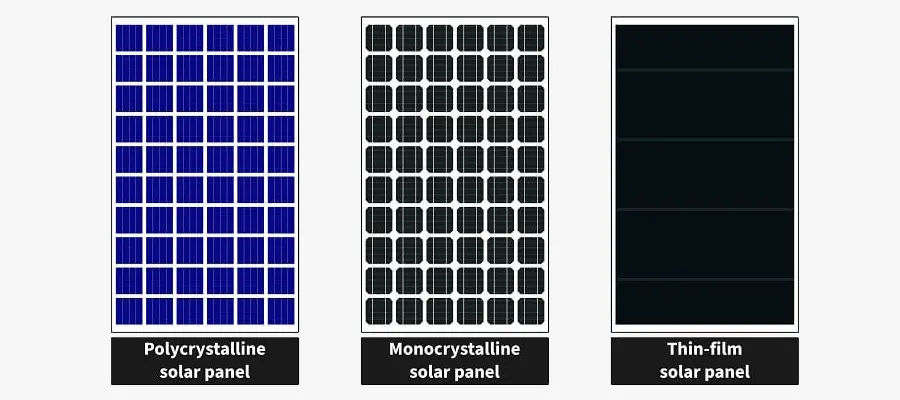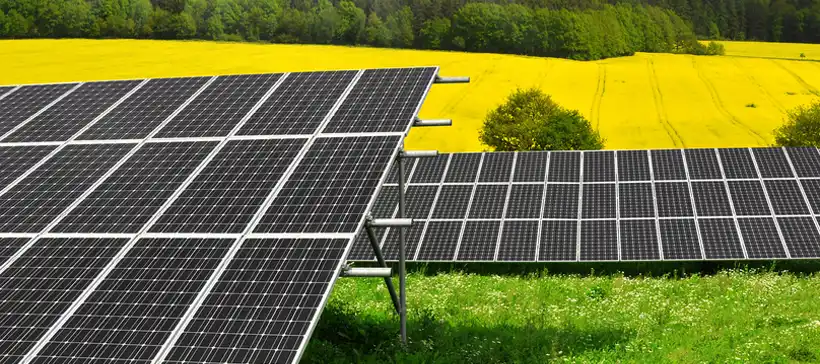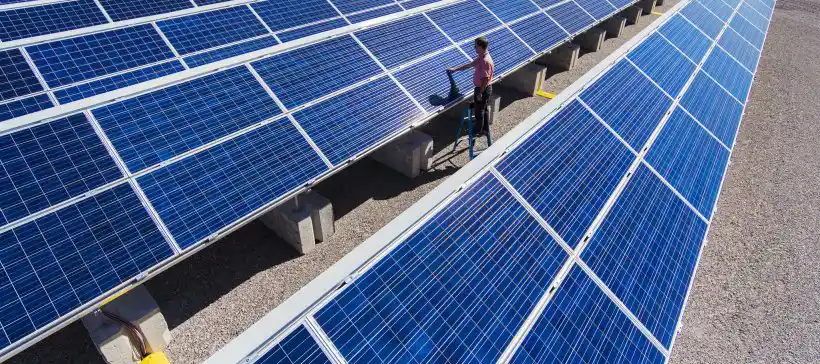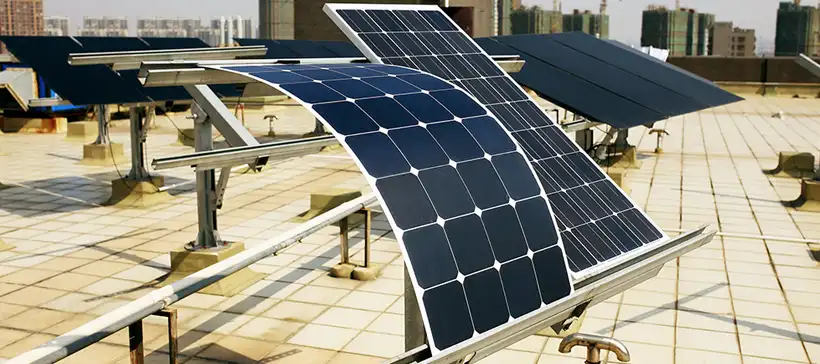- HOME
- ABOUT US
- SOLUTIONS
- Metal Roof PV Mounts and Systems
- Flat Roof Solar Panel Mounting Systems Solutions
- Tile Roof Solar Mounting Systems Solutions
- Solar Tracking Solutions for Commercial PV Projects
- Ground Solar Mounting Systems Solutions
- Floating Solar Solutions - PV Systems
- PV Solar Carport Mounting Systems Solutions
- Balcony Solar Panel Mounting Systems Solutions
- PRODUCTS
- PROJECTS
- COMPANY NEWS
- BLOG
- Contact Us

Monocrystalline solar panels, polycrystalline solar panels, and thin film solar panels are the three most common types of solar panels on the market. These solar panels differ in appearance, performance, cost, and manufacturing method.
If you're thinking about going solar, scroll down to see which type of solar panel is best for you. We'll walk you through the key distinctions, costs, and efficiency ratings of each type.
What is a Solar Panel?
Solar panels capture solar energy from the sun and convert it to electricity. A typical solar panel is made up of individual solar cells that are made up of layers of silicon, boron, and phosphorus. The positive charge is provided by the boron layer, the negative charge is provided by the phosphorus layer, and the silicon wafer serves as the semiconductor.
When photons from the sun strike the panel's surface, they knock electrons out of the silicon "sandwich" and into the electric field generated by the solar cells. This produces a directional current, which can then be converted into usable power.
The entire process is known as the photovoltaic effect; therefore, solar panels are also known as photovoltaic panels or PV panels. A standard solar panel has 60, 72, or 90 individual solar cells.
Monocrystalline Solar Panels

The term "monocrystalline" refers to the material used to make these panels, which is single-crystal silicon formed into bars and cut into wafers. Monocrystalline solar cells are one of the most popular panel types, despite being the more expensive option.
The high-efficiency rating of monocrystalline is one of the main reasons for its popularity. Because a monocrystalline cell is made up of a single crystal, the electrons that generate an electric current have more room to move. As a result, monocrystalline solar cells are more efficient than polycrystalline solar cells, with efficiency ratings ranging from 15% to 19%.
In fact, monocrystalline solar panels have the highest efficiency on the market, reaching up to 24% efficiency in some cases.
● Price: Because the manufacturing process is more complicated, monocrystalline solar cells are slightly more expensive than polycrystalline and thin film solar cells.
● Efficiency: approximately 15-19%.
● Lifespan: After 25 years, you can expect approximately 80% efficiency.
Polycrystalline Solar Panels

In contrast to monocrystalline solar cells, polycrystalline solar cells have a bluish hue because light reflects differently off the silicon fragments in the cell than it does off a monocrystalline silicon wafer.
However, because their silicon purity and construction are lower than that of monocrystalline panels, they are less efficient in terms of energy conversion and space. They are also less heat tolerant, making them less efficient in high-temperature environments.
● Price: Polycrystalline solar panels are slightly less expensive than monocrystalline solar panels because the manufacturing process is simpler.
● Efficiency: approximately 13-16%.
● Lifespan: After 25 years, you can expect approximately 80% efficiency.
Thin-film Solar Panels

Thin-film panels are distinguished by extremely fine layers that are flexible. Because each panel does not need a frame backing, they are lighter and easier to install. Unlike crystalline silicon panels, which come in standard sizes of 60, 72, and 96 cells, thin-film panels can be customized to meet specific needs. They are, however, less efficient than standard silicon solar panels.
● Price: Thin film solar panels are slightly less expensive than crystalline solar panels, but they have a shorter lifespan.
● Efficiency: approximately 7-13%.
● Lifespan: In general, a crystalline solar panel has a longer lifespan.
Thin-film solar panels, as opposed to crystalline panels, are made of different materials. They are as follows:
● Cadmium telluride (CdTe)
● Amorphous silicon (a-Si)
● Copper indium gallium selenide (CIGS)
1. Cadmium telluride (CdTe)
CdTe cells have the same low cost advantage as polycrystalline cells while having the lowest carbon footprint, water requirement, and energy payback time of any solar panel type. However, because cadmium is toxic, recycling it is more expensive than recycling other materials.
2. Amorphous silicon (a-Si)
The name amorphous silicon panels (A-Si) comes from their shapelessness. Unlike monocrystalline and polycrystalline solar cells, silicon is not molecularly structured.
On average, an a-Si cell uses a fraction of the silicon required to produce standard silicon cells. This allows them to have the lowest production costs while sacrificing efficiency. As a result, a-Si panels are well suited for low-power applications such as pocket calculators.
3. Copper indium gallium selenide (CIGS)
A thin layer of copper, indium, gallium, and selenium is deposited on a glass or plastic backing in CIGS panels. This combination produces the highest efficiency among thin-panel types, though it is still not as efficient as crystalline silicon panels.
Solar Panel Types by Power Capacity
Because of their single-crystal construction, monocrystalline cells have the highest power capacity, allowing for a higher output rating in a smaller package. Most monocrystalline panels have a power capacity of up to 300w.
Polycrystalline panels have bridged the gap due to recent advances in solar technology. A standard 60-cell polycrystalline panel can now produce between 240 and 300w. However, in terms of power capacity per cell, monocrystalline panels continue to outperform polycrystalline panels.
Because thin-film panels do not come in uniform sizes, there is no standard measure of power capacity, and the power capacity of one thin-film panel will vary based on its physical dimensions. In general, conventional crystalline panels produce more power than thin-film panels with the same physical footprint.
Which Type of Solar Panel Is Best for You?
When determining which type of solar panel is best for you, you must consider what is most important to you. We've listed four major concerns for people thinking about solar panels and recommended the best panel for each one below.
● Affordability: Monocrystalline panels may not be an option if you're on a tight budget, as they are the most expensive type. In this case, polycrystalline solar panels are preferable because the upfront costs are lower, and they absorb energy more efficiently than thin film panels.
● Aesthetics: Monocrystalline panels are the way to go if you're more concerned about how a solar panel system will look on your roof. These sleek panels have a modern, symmetrical look that will complement any home. If you want to take it a step further, you can consider integrating solar panels into your roof or using solar roof tiles.
● Inadequate roof space: Concerned that your roof will not have enough space for panels? Monocrystalline panels should be used. Because they are more efficient, they produce more in any given area.
● Efficiency: If the amount of sunlight your panels can convert into energy is your only concern, we recommend getting a set of monocrystalline solar panels. They have the highest efficiency rating on the domestic market and are your best bet for lowering your energy bills.

